Paynes Prairie is a 21,000 acre savannah located just south of Gainesville. It is home to 270 species of birds, alligators, American bison, Cracker cattle, and Cracker horses that are descendants of the Spanish Colonial horse group. The bison and the horses have been in the news lately with renewed discussion of a “livestock management” plan to cull the herds and to rope some of the remaining off for easy viewing pleasure. The livestock has occasionally left the park’s perimeter and the herds are slowly growing. Risk and liability are key factors, apparently, in the decision-making process.
I want to go on record as opposing the herd reduction. Thus far, there is no record of personal injury by a cow, bison, or horse. On those grounds and until such a record changes, I would like to see the preserve’s livestock left intact. The horse population in particular is so small as to be almost invisible on the large prairie basin.
In addition, the penning of animals for viewing pleasure strikes a very sour chord with me; it is zoo-like and speaks to additional marketing opportunity for the park. I envision a “Horses of the Conquistadors” attraction for the tourists, and this area of Florida is in desperate need of tourist dollars. In the wild, the livestock is infrequently seen and is known to be difficult to spot, so penning it in smacks of taking advantage for the purpose of increasing tourism potential.
The Cracker horse herd is said to be anywhere from 16 to 30 in number, with a high juvenile mortality rate. This is a small herd and the plan wishes to remove any stallion from the number so that future breeding is stopped.
On Sunday, Mr. B. and I went to the Bolen Bluff area of the prairie to look for birds. Bolen’s Bluff is made up of two distinct portions: one, the savannah basin and the other a wooded bluff over the prairie. The bluff contains a 2.5 mile circular loop trail and you can access the prairie by taking either direction of the loop.
As we made our way along the western edge of the loop, we ran into a man who asked us if we had seen a pony in the woods. We hadn’t, and we hadn’t seen any evidence of horses when we visited the trail six weeks ago either. Still, the mention of a pony was intriguing enough that we talked about it, wondering whether the wild horses had come up off the prairie floor.
After we walked a few minutes more, we saw a large pile of horse dung by the side of the trail. We walked a bit beyond that and suddenly there was a rustle in the bushes and a sense of heavy movement against the crackling of leaves. We turned and saw a glimpse of brown among the trees. It was a horse. First one, and then two more, brown horses moved slowly through the leafy woods. Two of the horses were adult and the other was a juvenile. They walked slowly and without agitation, brushing against branches and limbs as they went by. They emerged on the trail and stopped to chew on grass.
A minute or so later, I heard another noise and turned to see a white stallion moving through the woods. He, too, walked slowly and without any apparent concern. He paused where the others had been and grazed for a few minutes, and then he, too, moved off up the trail. We didn’t approach or rile the animals, we just shared a few moments of common space. The horses were aware of our existence but did not appear to be alarmed by us. Both horse and human gave each other respectful berth.
We continued along the wooded trail and then walked the length of the prairie basin trail that ends in an observation platform. That day, the most noticeable thing was drought. There was no sign of water (or more than a lone owl flying in the distance) and the vegetation was dried and brown. We rested for a few minutes and then reversed direction.
Mr. B. suggested that we go back the way we had come, to see if we might find the horses again. It was his conjecture that the horses had come up off the basin to drink from a small, algae-covered pond that is tucked back off the trail. Knowing that the horses were in the woods let us read their clues more easily: There was dung near a thin path leading to the pond and the smell of horse was easily sensed in the air in the same vicinity.
A bit farther along the trail, I noticed a man wearing a tie-dye shirt standing well off the trail. Just beyond him were the horses, now five in number and grazing in a less densely vegetated area. Mr. B. and I stepped off the trail and quietly approached. “Don’t disturb them,” the man admonished as if we were children, “Remember they are wild.”
If the low figure of the herd numbers is correct, then we were looking at 83% of it. Even if the high number of 30 is closer to accurate, five horses still represented a significant percentage of it. I don’t know anything about herd behavior, but unless a number of other horses split and went looking for water near the La Chua Trail (the bison seem to have done this), then what we saw was the Cracker horse herd that the state wishes to cull and pen in. The white stallion would be horse meat, I’m afraid.
The elusive horses that the state claims it will make visible in pens are now readily visible on the trails since they seem to have moved their base up onto the bluff. I thought back to the trip I’d made here some weeks ago, when I had seen a lot of bison dung on the savannah and no horse dung. This time around, there was lots of horse manure on the bluff and some coyote dung on the basin. The bison (and more coyote) dung was around the La Chua Trail, at the opposite end of the park.
Drought is the problem on the prairie, not overpopulation. Until such a time as bison stampede through downtown Micanopy and large herds of horses trample hikers, I going to hold firm on leaving things just as they are. I do understand that a park ranger was charged by a bison, but we don’t know the bison’s side of the story. Livestock leaving the park is not a terribly frequent event. Also, the discussion about the livestock hurting the ecosystem when it was supposed to help it sounds like a complaint that might be applied to humans, who outnumber the bison and horses by a ridiculous number.
This picture was taken on the prairie floor, looking northwards to Gainesville. As you can see, things are pretty dry out there.
We saw no sign of water, not even out by the rickety observation platform. Areas that had been filled with water before, small canals alongside the berm, were now dry.
I liked this reflection of a saw palmetto on the leafy forest floor.
The savannah trail.
Mr. B. approaches the observation platform at the end of the trail. This is .75 mile without shade from the woods, which is why I’d not made it out there before this.
A hardy little flower persisted in the tough conditions.
Mr. B. left the trail to investigate the little pond. Hoofprints were in the muck next to the water.
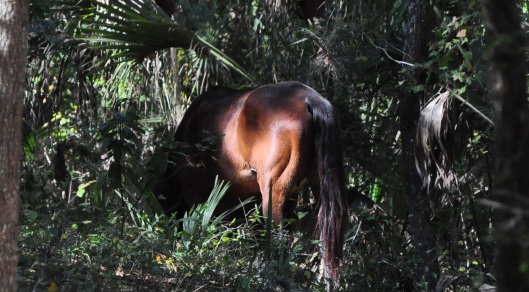
One of the brown horses comes through the woods and starts grazing next to the trail.
The white horse followed a few minutes later.

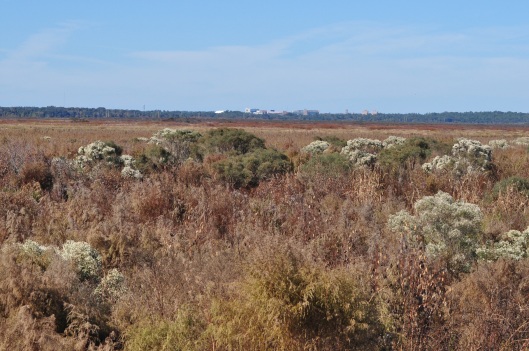
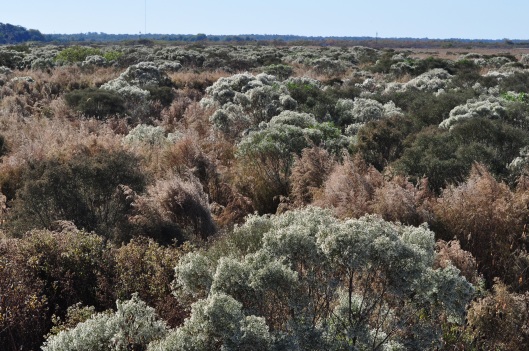

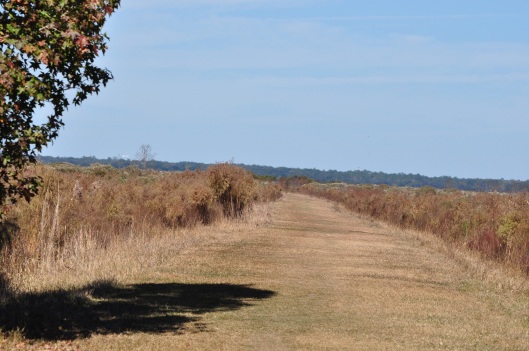
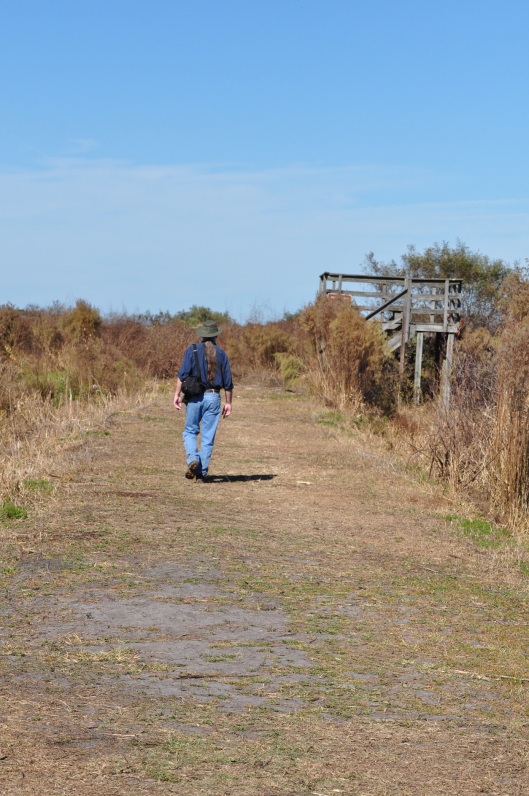
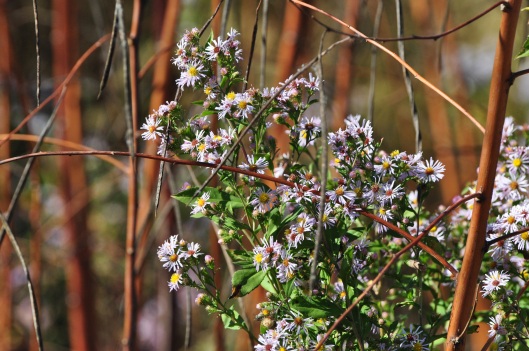
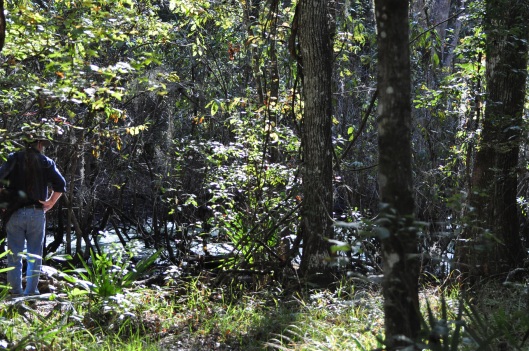
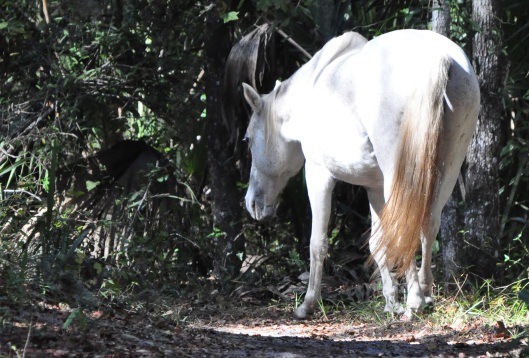
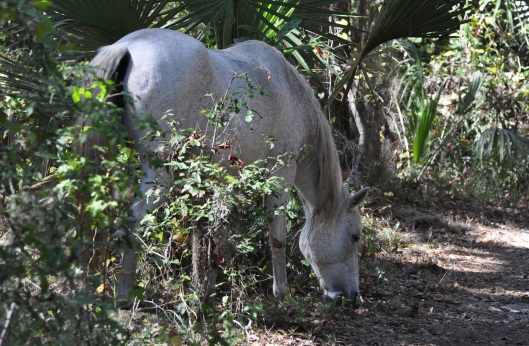
Thanks for posting this. I’ve heard (off the record) from several park service insiders that the reason they’re proposing to rid the park of horses and bison is that they don’t want to spend the funds to maintain the fences around Paynes Prairie–so instead, they want to get rid of anything that ought to stay within the fenced area. BUT–as a one park insider has pointed out publicly–they want to just give away the meat from the culled bison for free (have no idea what they plan to do with the horses)–as this person pointed out, if they simply culled a few animals every year (understandable, since they don’t have any natural predators) and sold the meat at market price, they’d have more than enough money to maintain the fences. And I agree with you–the idea of keeping a few symbolic animals in a penned-up area is repulsive. I hate how the park is getting paved and fenced and dumbed down for those who expect everything to look like Disney World!
Okay, end of rant!
The way the foliage looks you might not even recognize that you’re in Florida.
Felicia, your rant is welcome here! Thanks for adding some more perspective to this issue.
It is getting dumbed down, but I’ve seen some dummies using it. And, alligators that swim around excited by visitors are alligators that have been fed by visitors.
Ah Flawda…glad someone is paying attention, Suzanna.